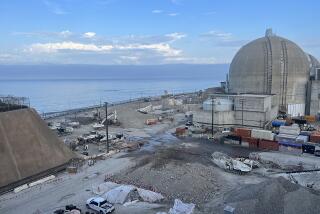Science / Medicine : SEEKING A SOLUTION TO ‘The Ultimate Pollution’ : Work is under way on a method to neutralize radioactive wastes through a process called transmutation. If successful, it would offer an alternative to burying the dangerous material underground for thousands of years.
- Share via
Radioactive waste has been called the “ultimate pollution.” Produced in massive quantities, deadly in microscopic amounts and dangerous for hundreds of thousands of years, it has proved to be the Achilles’ heel of nuclear energy.
However, work is now under way at Los Alamos National Laboratory in New Mexico and at other national research centers on a way to neutralize radioactive wastes through a process called transmutation.
The work is still in preliminary stages but if the process proves successful, it has tremendous implications for cleaning up the mountains of waste created through 40 years of nuclear weapons production and energy generation, and for future energy systems.
Its supporters believe it could provide an alternative to the U.S. Department of Energy’s longstanding, and extremely controversial, plans to dispose of the nation’s high-level radioactive wastes in “deep geologic” waste facilities--such as the proposed Yucca Mountain facility in Nevada. There are concerns that these underground repositories will not function as designed to sequester their toxic contents over the tens of thousands to hundreds of thousands of years required.
Old Idea Recycled
But transmutation has its detractors, including the Department of Energy. The critics point out that the technology is relatively untested and may require an inordinate amount of energy to operate. But more ominously, they fear that the concept is capable of backfiring and generating even more waste than it is trying to dispose of.
Transmutation has already been successful in small experiments at the department’s Hanford, Wash., facility using a traditional nuclear reactor. But Los Alamos is working on developing a system based on use of a linear accelerator. This process, say researchers, holds many promising advantages to the reactor-based transmutation systems--including safety, efficiency (a reactor generates more waste as it transmutes waste) and the possibility of producing surplus power while transmuting wastes.
In a linear accelerator, elementary particles are accelerated to high velocities by a series of massive electromagnets aligned in a row. In a nuclear reactor, high-speed elementary particles are produced by nuclear fission reactions, in which unstable radioactive isotopes break down into more stable products, releasing the particles as byproducts. Essentially, transmutation is a twist on the age-old alchemical idea of transforming one element into another--in this case radioactive wastes into non-radioactive materials or materials with much shorter radioactive life spans.
The process takes place when subatomic particles, especially neutrons under the right conditions, penetrate atomic nuclei. The neutron may be absorbed, creating an isotope of the original element, or it may create an unstable atom, which then fissions or decays.
In either process, the original atom is transformed into a different one. For instance, when transmuted, technetium-99 becomes ruthenium-100, a non-radioactive element, while iodine-129 becomes the stable element xenon-130.
Other radioactive isotopes have their half-lives (the time required to lose half of their radioactivity through natural decay) cut dramatically--in the case of plutonium-129, from 24,000 years to several decades.
This would allow the transmuted wastes to be placed in surface or near-surface storage facilities, where they would naturally decay over a few decades into non-harmful materials.
The Los Alamos transmutation process under study offers some additional, unique advantages. Its use of a linear accelerator rather than a traditional nuclear reactor to “drive” the process enables the system to handle heavier elements like plutonium and neptunium, as well as their byproducts of fission, like technetium-99 and cesium-135. Nuclear reactors can transmute only the heavier elements.
It also promises to be much safer than a reactor-based system. Because an accelerator transmutation system could operate with small amounts of waste (220 pounds compared to roughly 11 tons required by earlier systems), and would function on power derived from an external source, it would also be immune to an uncontrolled chain reaction.
How It Works
The system would use a linear accelerator to produce an intense beam of fast-moving protons. Los Alamos has the world’s most powerful medium-energy accelerator and through research on the Strategic Defense Initiative (“Star Wars”), is developing accelerator beams hundreds of times more powerful than that.
A beam produced by such an accelerator would be directed into a target of lead or tungsten, where each proton would “knock out” more than 50 neutrons from the target atoms. This would create a high-intensity neutron field around the target, which would then be ready for the arrival of the radioactive waste.
Through advanced chemical separation processes under development at Los Alamos and other research facilities, the waste would be separated from nuclear fuel rods used in reactors or from the waste stream created in the reprocessing of fuel for nuclear weapons. It would then be mixed into a water or molten salt solution.
This waste-bearing solution would be circulated in pipes around the target area. The neutrons in the target area, slowed by a “blanket” of heavy water, would penetrate the carrier loop and be absorbed by the radioactive materials, transmuting them into other elements.
As waste became converted into nonradioactive, stable isotopes, these end products would be continuously removed from the waste flow and new radioactive waste introduced.
In addition to waste-handling functions, researchers envision advanced linear accelerator systems generating more than enough power to run themselves. Small amounts of the transmuted materials, along with other elements, would produce temperatures in the molten salt of about 700 degrees. This heat would be used to drive turbines, producing electricity. Ideally, about 20% of the energy produced would go to running the accelerator; the rest would be fed into a regional power grid, converting the waste problem into a source of power--a modern silk purse from a sow’s ear.
“This is still mostly concepts,” noted Edward Arthur, head of the Los Alamos transmutation team. “We are only at the beginning stage of technical detail.”
Arthur estimates it will require 12 to 15 years to perfect the process and an investment of $1 billion to $3 billion. So far, about $1 million has been committed to the project in Los Alamos discretionary funds and $2 million from the Department of Energy.
But the program is receiving a frosty reception from officials responsible for overseeing such research. Clyde Frank, the department’s associate director of environmental restoration and waste management says, “The jury is still out . . . transmutation is not a cure-all. It doesn’t replace deep geologic repositories.”
In fact, Frank and others feel transmutation may actually increase the amount of radioactive waste through “activation” of non-radioactive materials in the separation process and the transmutation system itself. Mike Stevenson of the Los Alamos research team noted, “We are looking into how system materials will hold up and how often you will have to replace parts.”
John Rawlins of Westinghouse Hanford in Richland, Wash., says reactor-based transmutation has been intensively studied for the past three years at the Fast Flux Test Facility in a program called CURE--Clean Use of Reactor Energy. An associated project has developed an advanced separation process called TRUEX for extracting transuranic elements from other actinides.
“Our initial conclusion is that the concept might work,” he said, “though there are difficult political and institutional hurdles to cross.”
Others wonder about the energy requirements. John Stroud, a lawyer and physicist with a Santa Fe-based group called Concerned Citizens for Nuclear Safety, noted, “The system appears to be highly energy unfavorable.” He estimates it will require about $2.5 million in energy to transmute each kilogram of waste. “That’s why they hope to generate surplus energy,” he said--to offset this cost.
But, notes Charles Till, associate director for engineering research at Argonne National Laboratory in Illinois, “nuclear waste . . . is a Grade A, No. 1 problem for the commercial power industry and the Department of Energy’s weapons program. A few million dollars or tens of millions spent on what could be done to reduce the actual or perceived risk in comparison to the estimated $30 billion that will be spent on the first deep geologic repository for high-level wastes--it seems common sense that this should be done.”
Widespread Interest
Widespread interest is also coming from the international scientific community and corporate interests, says Arthur. In June, at a Swedish radioactive waste management conference attended by European, Soviet and Japanese scientists, discussion of the Los Alamos transmutation program dominated the agenda. In October, the Los Alamos team made its second presentation to industrial and corporate representatives interested in the commercial possibilities of both waste destruction and power generation.
The first application of the Los Alamos process, if it proceeds as envisioned, will most likely be on waste currently held at the Hanford reservation. Much of this waste related to nuclear weapons production has already undergone reprocessing: Fuel rods have been dissolved in an acid bath and their uranium and plutonium extracted. The liquid waste would undergo further separation and then enter a transmutation system featuring an accelerator. Should this prove successful, larger plants could be built elsewhere and the process, perhaps, expanded to include commercial wastes from power plants.
Obviously, there are many important and challenging steps to be taken before the Los Alamos transmutation process can be proved one way or another. But with nuclear waste piling up around the world and no demonstrable means of safely isolating or treating it, proponents believe accelerator transmutation clearly offers at least a glimmer of hope on an otherwise bleak horizon.
Neutralizing Nuclear Waste Transmutation is basically a twist on the age-old alchemical idea of transforming one element into another. In this case, radioactive wastes would be changed into non-radioactive wastes would be changed into non-radioactive materials or materials with much shorter radioactive life spans. How It Would Work 1-- A linear accelerator would produce an intense beam of fast-moving protons to be directed into a target of lead or tungsten, creating a high-intensity neutron field around the target. 2-- Radioactive waste would be circulated in a water or molten salt solution around the target area. Neutrons would penetrate this carrier loop and be absorbed by the radioactive materials, transmuting them into non-radioactive materials. 3-- The now-transmuted wastes would be drawn into a heat exchanger for extraction of thermal energy. 4-- The wastes would then go through an advanced chemical separation process where the now-stable and short-lived radioactive wastes would be extracted, and new wastes fed into the process. THE PROPOSAL A-- High-level, extremely long-lived radioactive wastes now in storage around the nation would be processed into a liquid form. B-- The liquid would then be subjected to a high-intensity neutron field created by a linear accelerator, altering the waste materials. See diagram at left. C-- These products would then undergo chemical separation, dividing them into non-radioactive and short-lived radioactive wastes that could be stored until no longer dangerous.






